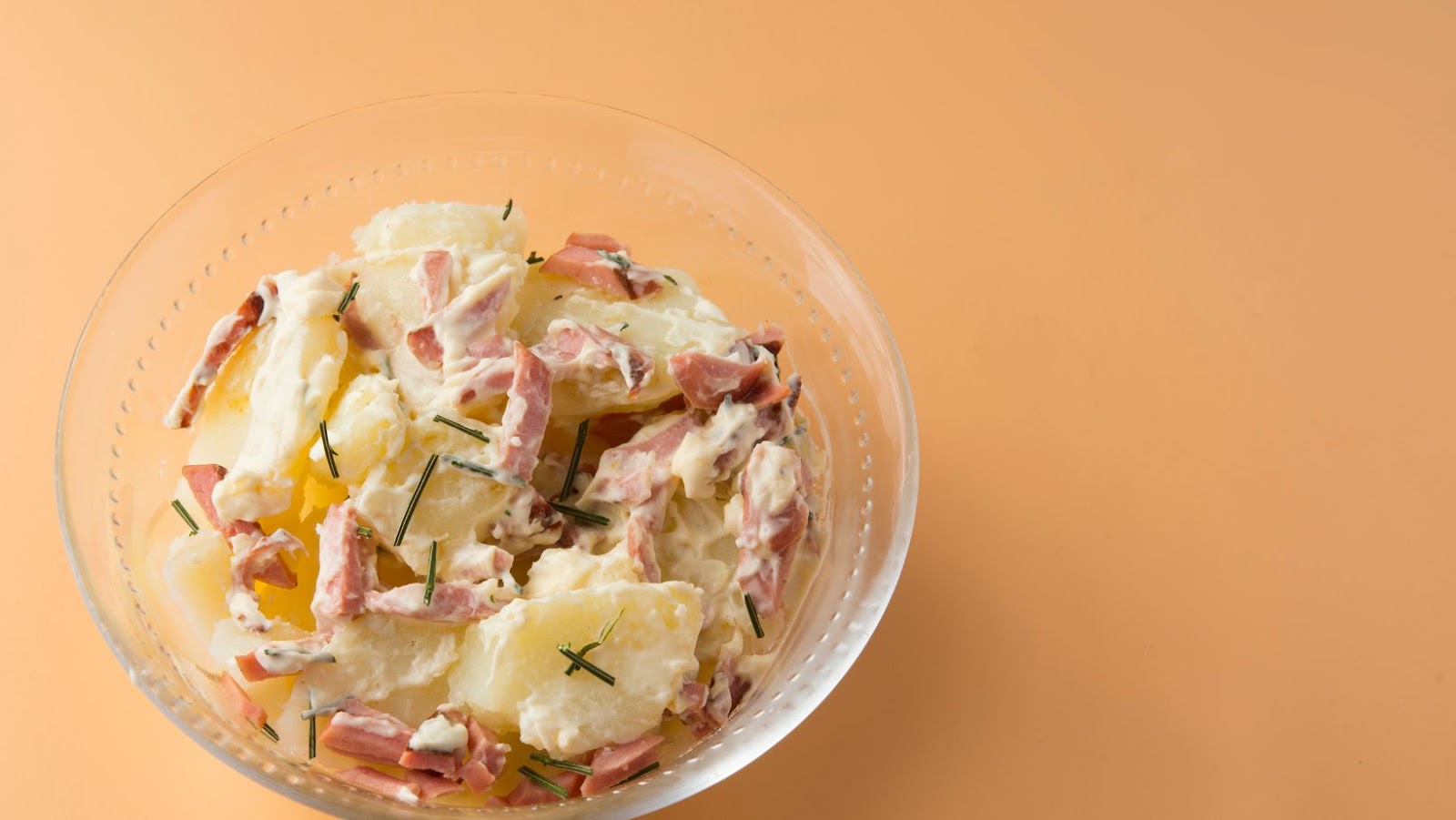To keep your potato salad fresh and tasty for longer, you need to know the alternatives to freezing it. Whether you want to store potato salad in the fridge or use vacuum sealing, airtight containers, adding vinegar or oil, or using mayonnaise, lemon juice, sour cream, yoghurt, or buttermilk, this section on alternatives to freezing potato salad has got you covered.
Can I Freeze Potato Salad
Preserve leftover potato salad with refrigeration. Place it in an airtight container that seals properly to avoid moisture loss. Don’t store large quantities in one container. Consume within 2-3 days if you have more leftovers than you can finish. Consider freezing smaller portions, however this may change the flavour and texture of some ingredients.
Non-dairy based potato salads – remove any garnishes or toppings and store them separately, then cover with plastic wrap or aluminium foil. Place the bowl inside an airtight container in the refrigerator.
Potato salads have been around for centuries. Initially made out of boiled potatoes, oil and vinegar dressing, salt and pepper. Over time, additional ingredients were added. Now, there are many varieties enjoyed globally like German Potato Salad and Southern Potato Salad.
Vacuum sealing is a great way to keep your potato salad fresh, without using up freezer space.
Vacuum Sealing
Preserving potato salad with a sophisticated air-containing system is known as space removal. Vacuum sealing removes the air from the container or bag. This offers numerous advantages like:
- Stops freezer burn and extends shelf life without affecting the taste
- Maintains freshness by blocking oxidation
- Maintains texture and consistency of the salad, prevents ice crystals
- Helps in portion control and storage
- Creates an airtight seal which protects it from outside factors like moisture, bacteria, and insects
- Saves time and money compared to traditional freezing methods
Vacuum sealing also eliminates any excess air pockets in between the contents in the container or bag, reducing compression on the dish. This way, each bite preserves its flavour and texture.

For extra safety, label your containers with the date of preparation and name of contents before vacuum sealing. This helps track what’s inside the vacuum-sealed bags or containers.
A professional chef suggests vacuum-sealing for preserving potato salads during gatherings. In one event, she prepared around 15 pounds of potato salad for a catering order. It was easy to transport dishes to different locations without worrying about spoilage or sogginess. Her clients were very satisfied with her services.
Lock up your potato salad safe and sound with airtight containers, just like a prisoner.
Using Airtight Containers
Airtight containers are popular for preserving potato salad, instead of freezing. They keep ingredients fresh and extend shelf life. Here’s why:
- Tight seals block air and moisture, preventing bacteria growth.
- Flavours and texture last.
- Plastic or glass lids come in different sizes.
- Stackable, saving space in the fridge or freezer.
- Quick access, no thawing required.
- Avoid hardening potatoes.
For best results, keep acidic components separate until serving. For extra flavour, add vinegar when ready to serve!
Adding Vinegar
To extend the shelf life of potato salad, add an acidic element like vinegar. One tablespoon for every cup of salad is ideal and should be added after all other ingredients are mixed. Instead of homemade mayonnaise or yoghourt-based dressing, use pasteurised mayonnaise or sour cream. Also, store the salad in mason jars or air-tight containers at a temperature below 40°F and consume within four days if kept refrigerated. Avoid oil as it could damage the salad.
Adding Oil
Enhance the flavour and texture of your potato salad without freezing it! Incorporate oil for an extra layer of flavour. Choose a high-quality oil such as olive, avocado, or walnut oil. Start with a tablespoon or two and gradually add more. Mix well so every bite is evenly coated. Adjust seasoning as necessary.
Be cautious not to use too much oil – it may result in a greasy finish. Store in an air-tight container and refrigerate promptly.
Don’t miss out! Mayonnaise is like a warm, comforting hug from a jar. Experiment with this scrumptious side dish – you won’t regret it!
Using Mayonnaise
Mayonnaise is a great sub for freezing potato salad! Here are some creative uses:
- Mix mayo with vinegar and mustard to make a creamy veggie dressing.
- Use mayo instead of melted butter on grilled foods.
- Spread it on bread before grilling sandwiches for a golden crust.
- Combine sour cream or yoghourt with mayo and herbs to make dips.
- Add flavour to mashed potatoes, deviled eggs, and other dishes with some mayo.
- Spread a thin layer on top of baked goods to seal in the moisture.
Remember to refrigerate potato salad made with mayo and use within one or two days – storing it for a long time increases the risk of bacteria growth. Fun fact: 70% of mayo consumption happens at home, according to a 2019 survey by The NPD Group. A dash of lemon juice adds zest to potato salad!

Adding Lemon Juice
Preserve the quality of your potato salad with citrus juice! Lemon juice, in particular, helps keep it fresh and stops it from turning brown. The citric acid acts as an antioxidant, blocking oxidation and making it last longer.
Simply add a few teaspoons of freshly squeezed lemon juice while mixing the ingredients. Be careful not to add too much, as it can alter the taste. Balance it with other flavours for a zesty flavour that’s refreshing and appetising.
Other alternatives to preserve your potato salad include storing it in air-tight containers or vacuum sealer bags in the fridge. Additionally, adding vinegar or citrus zest like orange or lime can act as preservatives while adding to the taste and aroma. And if you’re feeling adventurous, why not try sour cream for an extra rich flavour?
Using Sour Cream
Sour cream can be a great way to save your potato salad from going bad! Here are some ideas:
- Replace mayonnaise with sour cream – it has less fat and won’t spoil as easily.
- Add sour cream to the salad just before serving for extra flavour.
- Mix potatoes and sour cream before adding other ingredients, then store in the fridge.
- Use Greek yoghurt or buttermilk instead of mayo for a tangy twist.
- Mix half mayonnaise and half sour cream or Greek yoghurt for fewer calories.
- Refrigerate the potato salad quickly after mixing. Store above 40°F and bacteria will grow, increasing spoilage risk.
Adding acidic ingredients like vinegar or wine can also help prolong shelf life. But take care when handling food items – according to USDA research, dressings should be stored no more than three days in the fridge. This way you can reduce potato wastage and keep them fresh and delicious!
Using Yoghourt
Yogurt is an amazing alternative to mayonnaise and sour cream! It adds creaminess and tanginess to the salad while also providing live and active cultures, which are great for digestion. Greek or plain yoghurt can be used, depending on your preference. To enhance the flavour profile, herbs like dill and chives can be added. Lemon juice provides a zesty refreshing touch.
Not only does yoghourt elevate the taste of potato salad, but it also brings nutritional benefits. Plus, you can store it in an airtight container and serve it cold, making it perfect for those days when you’re short on time.
I once used yoghourt in my potato salad recipe for a family barbecue. Everyone loved it, especially my health-conscious aunt, who was able to enjoy her favourite dish without compromising her diet. Buttermilk is the secret ingredient to making potato salads truly delicious!
Using Buttermilk
Buttermilk as a Flavorful Alternative for Potato Salad!
Why not try buttermilk in your potato salad? Here’s 6 creative ideas:
- Use buttermilk instead of mayonnaise in the dressing
- Mix in some sour cream
- Sprinkle in fresh herbs like dill or parsley
- Minced garlic or shallots for an extra kick
- Bacon bits or crumbled blue cheese for a tangy taste
- Pickle onions with buttermilk and vinegar, and toss them in
For an extra creamy texture, soak boiled potatoes in cold buttermilk for an hour. Then adjust the seasonings and salt levels to taste before serving. Pro Tip: If you don’t like heavy dressings, this tangy buttermilk alternative is for you!
Keep potato salad fresh by not letting it stay in the fridge for more than two hours.
Tips for Storing Potato Salad
To ensure your potato salad stays safe and delicious, use these tips for storing potato salad. Keep potato salad at a safe temperature, avoid cross-contamination, properly store leftovers, and discard any spoiled potato salad. By following these sub-sections, you can enjoy your potato salad without the risk of food poisoning or a spoiled meal.

Keeping Potato Salad at a Safe Temperature
Maintaining a proper temperature for potato salad is important for preventing foodborne illness. Here’s a 6-step guide:
- Keep it at 40°F or below before serving.
- Put it over ice or an ice pack if it’s outside.
- Don’t leave it out for too long – use timers and alarms.
- Insulated bags or coolers with ice packs are best for transporting.
- Keep it covered and away from raw foods with strong odours in the fridge.
- Throw away any leftovers within 3-5 days.
Don’t forget to follow health code regulations in your area! Temperature control is crucial for flavour and safety. Stop potato salad from mingling with other foods in the fridge, or you may have a food poisoning disaster. Store-bought salads can also be risky due to preservatives, so be sure to check expiration dates.
Avoiding Cross-Contamination
To keep your potato salad fresh and safe, follow these 6 steps:
- Wash hands before and after handling the food.
- Use separate cutting boards, utensils, and containers for raw and cooked ingredients.
- Store cooked potato salad in a separate container from raw meats or other high-risk foods.
- Cool potato salad before placing it in the fridge.
- Keep the fridge below 40 degrees Fahrenheit.
- Avoid leaving the potato salad at room temperature for more than 2 hours.
Don’t forget to discard leftovers if they’ve been sitting at room temperature for more than two hours. Put a label with the date on it so you can track how long it’s been stored in the fridge. This will help keep your potato salad safe and fresh for longer!
Properly Storing Leftovers
Storing Leftover Food the Right Way
When it comes to leftovers, quality and safety are key. To keep food fresh and safe, proper storage is essential. Here are some tips:
- Store leftovers within two hours of cooking.
- Cool hot foods before storing in containers.
- Use air-tight containers or wrap tightly with foil/plastic wrap.
- Label with name, date and contents for easy identification.
- Reheat leftovers at 165-degree Fahrenheit before consuming.
Store different food types separately to avoid cross-contamination. Acidic foods like fruits and tomato-based sauce may take on a metallic taste if stored in metal containers too long.
Did you know that proper storage can help reduce food waste? A study suggests that households waste almost a third of their groceries due to poor storage strategies. Storing leftovers properly lets you enjoy fresh, safe food and save money!
If your leftovers have gone bad, just “A-peel-y ever after” and toss them in the trash.
Discarding Spoiled Potato Salad
If your potato salad has gone bad, discard it to prevent health risks. Here’s how:
- Put it in a sealed container or bag.
- Put the container/bag in an outdoor trash bin, far away from food sources.
- Place spoiled potato salad in a separate trash bag to avoid contamination.
- Clean area where it was stored with hot, soapy water and disinfectant.
- Wash your hands after handling the spoiled salad and container.
Eating spoiled or expired potato salad can lead to foodborne illness. Don’t salvage any parts or find uses for leftovers. Get rid of it and start fresh.
Be mindful when storing perishable foods. Follow guidelines for temperature control and expiration dates. Prioritise food safety to protect yourself and others from getting sick.
Be careful when handling spoiled food. Always err on the side of caution and dispose of it properly. Store your potato salad correctly or you may end up with something inedible!
Conclusion
Potato salad is a yummy dish, but can it be frozen? Doing so alters the texture and taste. Not to worry though – there are two other ways to preserve it!
Firstly, store in an airtight container and pop it in the fridge for up to five days. Secondly, use natural preservatives such as lemon juice or vinegar to extend the shelf life to seven days.
Freezing potato salad is possible, however it’s not recommended. Opt for these alternatives instead for maximum freshness! Enjoy delicious potato salad for longer today!



